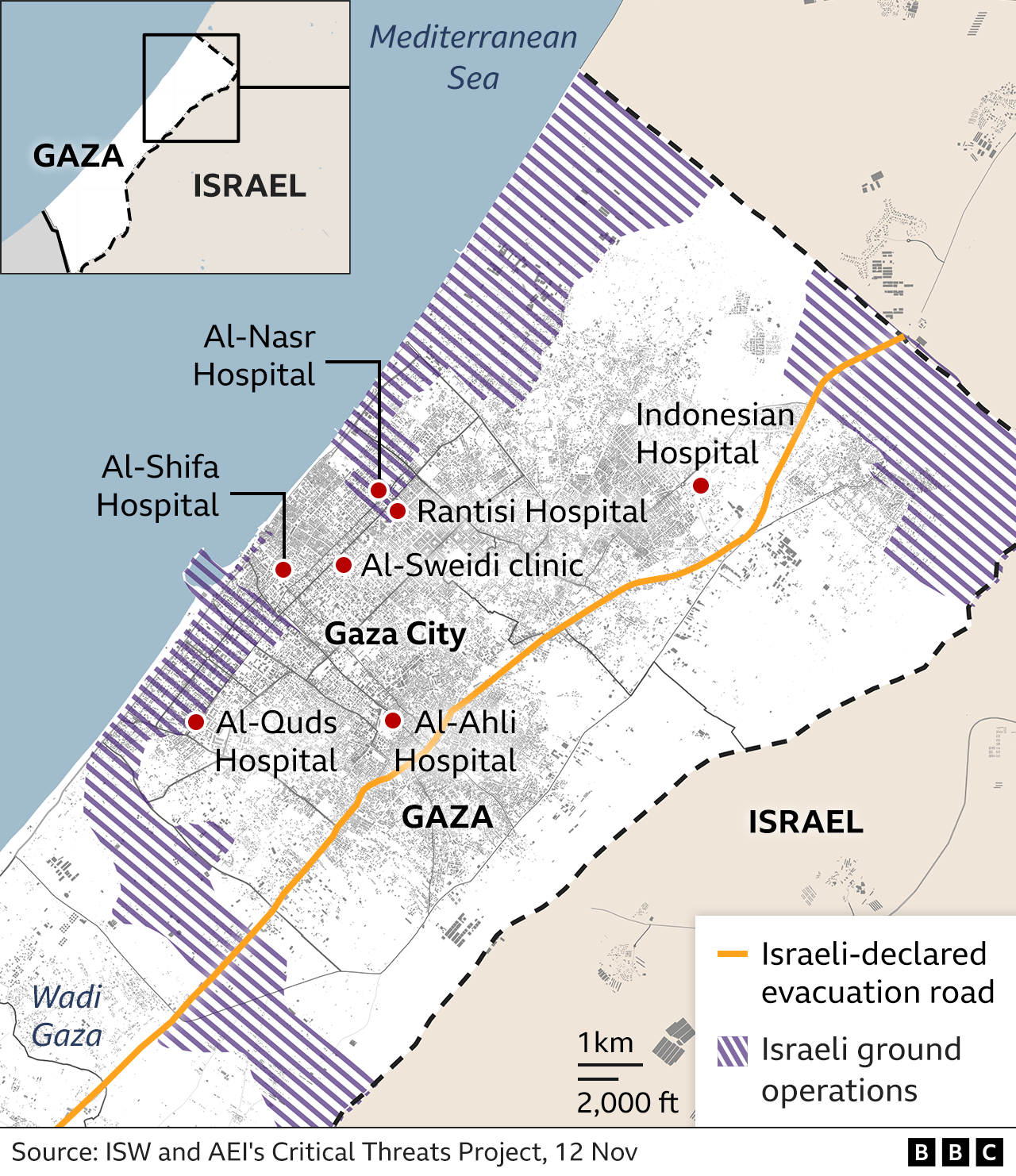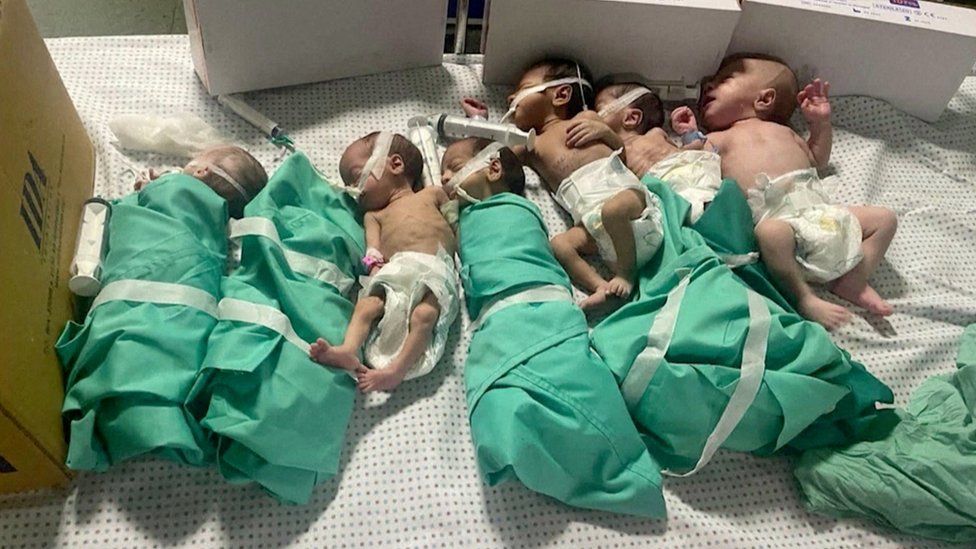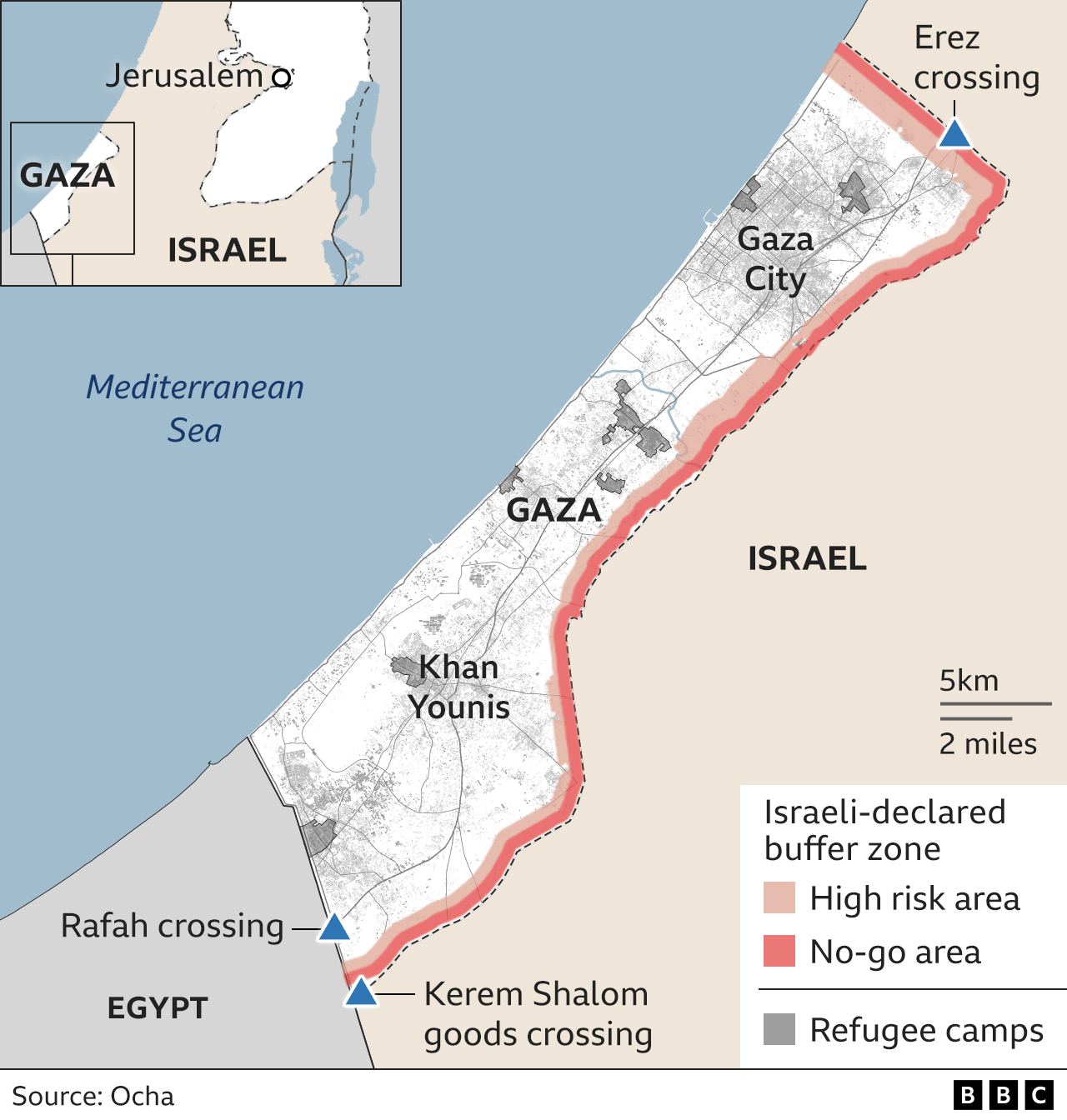Hamas gunmen launched an unprecedented assault on Israel from the Gaza Strip on 7 October, killing about 1,200 people and taking more than 200 hostages.
Israel responded with air strikes on Gaza and has launched a ground offensive. More than 11,500 people have been killed, according to the Hamas-run health ministry.
What is the goal of Israel’s military operation in Gaza?
Israel Defense Forces (IDF) warplanes are bombarding Gaza from the air while its troops are moving through the north of the territory.
Prime Minister Benjamin Netanyahu says Israel has a “clear goal of destroying Hamas’s military and governing capabilities”, as well as freeing the hostages.
On Monday, the IDF said that its aircraft and ground forces had conducted 4,300 strikes, hitting hundreds of anti-tank missile launch posts, 300 tunnel shafts and 3,000 “terrorist infrastructure sites” since 7 October.
It said 50 of its soldiers had been killed during the ground operation.
Mr Netanyahu has refused calls for a ceasefire unless the hostages are released.
He also said that Israel would have “overall security responsibility” for the Gaza Strip “for an indefinite period” after the war ended. However, the US warned him that Israel could not reoccupy the territory.
Israel has drafted 300,000 reservists to boost its standing force of 160,000. It believes Hamas’s military wing has about 30,000 members. The group operates from underground tunnels, which it has previously claimed stretch for 500km (310 miles).
- Could an Israeli ground invasion of Gaza meet its aims?
What is happening at the Al-Shifa hospital in Gaza?
Israeli soldiers remain inside the Al-Shifa hospital, the largest medical facility in northern Gaza. Both Israeli and US intelligence say the hospital was a key command centre for Hamas, which it denies.
On Wednesday night, the IDF said it was continuing its “precise and targeted operation”, and that it had killed “a number of terrorists” within the complex.
Israel said it had found a Hamas'”operational centre” in the hospital, sharing images of what it said were Hamas weapons and equipment.
Some of this material was shown to BBC correspondent Lucy Williamson, who was taken by the Israeli army into a small part of the hospital.
She was not allowed to speak to any doctors or patients, but her description of the visit was not censored.
- BBC goes inside Al-Shifa hospital with the Israeli army
- What we know about Israel’s raid on Al-Shifa hospital
- Bowen: Hospital raid comes as tone shifts on Israel

On Thursday, Palestinian Islamic Jihad – which is the second biggest armed group in Gaza – said it was fighting Israeli forces near the site. The Israeli military has not commented on the claim, which the BBC cannot verify.
The UN had said that more than 4,000 patients, staff and displaced people are inside the facility. This includes dozens of premature babies, who were removed from incubators because of power cuts, and kidney patients needing dialysis.
The World Health Organization (WHO) said it was “extremely worried” for their safety.
Israel says it has delivered incubators, baby food and medical supplies to the hospital.

Hamas called the operation targeting Al-Shifa a “war crime” and a “crime against humanity”.
The UN’s humanitarian chief, Martin Griffiths, said he was “appalled”, and that “hospitals are not battlegrounds”.
On Tuesday, US President Joe Biden said that hospitals and patients in Gaza must be protected.
- Gaza hospitals caught on front line of war
What else is happening on the ground in Gaza?
Israel says its jets attacked the Gaza house of Ismail Haniyeh, widely considered to be the overall Hamas leader.
Haniyeh lives in Qatar, but Israel says the house was being used as a Hamas meeting place.
Elsewhere, Palestinian media say around 50 people were killed by an air strike in the central Gaza Strip.
The IDF has repeatedly warned Palestinians in the north of the territory to leave their homes for their own safety and head south of the Wadi Gaza river, but has also continued to carry out air strikes in the south.
Israeli forces have also dropped leaflets in the Khan Younis area of southern Gaza, warning people in four towns to evacuate their homes.
Similar leaflets were dropped over northern Gaza weeks before Israel’s ground offensive began.
https://emp.bbc.com/emp/SMPj/2.50.8/iframe.htmlMedia caption,
Watch: Civilians leave northern Gaza on foot
The UN has said an estimated 200,000 have fled the north since 5 November. But it is increasingly concerned by overcrowding and limited access to shelter, food and water in the south.
It has also warned that hundreds of thousands of people – who are either unwilling or unable to leave – remain in the north and are struggling to secure the minimum amount of water and food to survive.
- Gaza Strip in maps: Life in Gaza under siege
- How the dead are counted in Gaza
What is the humanitarian situation in Gaza?
The UN’s high commissioner for human rights Volker Türk says that one in every 57 people living in the Gaza Strip “has been killed or wounded in the past five weeks”, based on Hamas-run health ministry figures. He spoke of the pain and “anguish” of both Israeli and Palestinian civilians as the fighting in Gaza continues.
The heads of all the major UN agencies have called for an “immediate humanitarian ceasefire”, as well as the unconditional release of hostages.
They said “cutting off 2.2 million Palestinians from food, water, medicine, electricity and fuel” was an “outrage”, and that more than 29,000 injured people “require immediate treatment”.
Only one hospital in northern Gaza – Al-Ahli – is still in operation, according to the UN Office for the Coordination of Humanitarian Affairs (OCHA).
Unrwa, the UN agency for Palestinian refugees, said 1.5 million Gaza residents have been displaced and 778,000 are sheltering at its facilities. Another 150,000 are believed to be taking refuge in hospitals and other public buildings.
Phone and internet services have been repeatedly cut, leaving people unable to call for ambulances or to contact the outside world.

The Rafah border crossing into Egypt, to the south, is the only functioning route for people and goods to leave or enter Gaza.
The crossing reopened for aid supplies on 21 October, but only a small number of the 500 lorryloads which used to arrive every day are currently getting into Gaza.
Israel has restricted fuel supplies so they cannot be used by Hamas, but on Wednesday, border officials said 25,000 litres of fuel had been allowed through for the UN’s use.
The UN said this was only a fraction of what was needed.
The border opened again for people to leave Gaza on 1 November. Hundreds of injured people and foreign passport holders – including more than 100 UK citizens – have since crossed into Egypt, but many more remain.
The crossing has shut, for short periods, several times since reopening.
